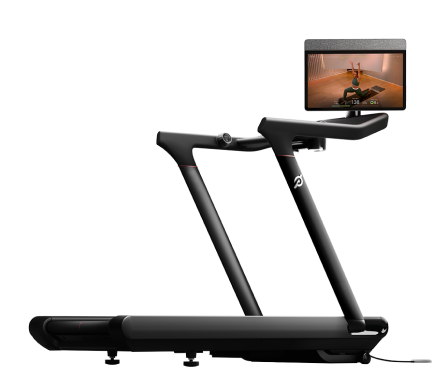
Tom Werner via Getty Images
5 Ways to Speed Up Your Sprints, Plus the Benefits of Sprint Training
You don't have to be a track star to benefit from sprint training.
By Jennifer Heimlich•
The Benefits of Becoming a Better Sprinter
How to Sprint Faster
Tips to Master Sprinting Form
Weightlifting Exercises That Can Help Improve Your Sprinting
How to Sprint Faster on a Treadmill
The Takeaway
For runners, there’s nothing quite like the rush of going all out in a sprint. Even those of us who typically keep things at a much steadier pace may find that hitting our top speeds can be a thrilling challenge. Peloton instructor Jon Hosking, for instance, loves the exhilaration of sprinting, finding that he enjoys “the test” and the “never-ceasing development and progression” of it. A sprint is like a pop quiz for your body that you can always get better at.
Discover more ways to reach your goals with Peloton
Yet despite how much fun it can be, learning how to sprint faster takes serious practice and dedicated training. Here’s what you need to consider if your goal is to get better at sprinting.
The Benefits of Becoming a Better Sprinter
To state the obvious, training your body to sprint faster can improve your top speeds as a runner. Even if you’re not planning to throw down on the track anytime soon, it can make things more fun when you join a weekend soccer game or play tag with the kids—and come in pretty handy if you need to chase after a train.
What might be more surprising is that becoming a better sprinter can also be useful when you’re not going all out. “For a distance runner, it makes their maximum capacities for speed a little bit higher, so when they're not running as fast as they can, it's a little bit less energy required,” says Iain Hunter, PhD, an exercise sciences professor at Brigham Young University. “They start to be able to maintain slower speeds for longer if they can be better at sprinting.”
Additionally, working on your sprints can be a form of strength training in disguise. “Sprinting helps encourage muscle growth,” Jon points out. Because you’re stressing your muscles close to their max effort and pushing the limits of what they can do, they’ll end up growing stronger. In fact, one 2017 study even found that sprinting was more effective at activating the hamstring muscles than many traditional hamstring strength training exercises.

Peloton App
Access thousands of classes with no equipment needed.
How to Sprint Faster
Becoming a faster sprinter takes more than just running as fast as you can. Consider these strategies:
Do Sprinting Drills
Hunter says that there are two main types of drills that sprinters do: those that are designed to build the strength and power needed to get into the positions necessary for sprinting (like high knee cariocas and A skips), and those that train the technique of sprinting itself (like strides). Beginner sprinters should start with the former, then work in the latter once they’re able to maintain proper sprinting positions at their top speed.
Start Gradually
When you’re new to sprinting, you want to begin training gradually. “We're adding a lot more strain to the body, and that can develop an overuse injury,” Hunter says. He recommends just starting with sprinting drills and 50- to 100-meter strides (close to but not hitting your all-out speed) twice a week at first, then adding in a third session after two or three weeks, and eventually turning up the intensity of those strides.
Take It to the Hills
Jon recommends seeking out some elevation when you want to teach your body how to sprint faster. “Hills can help hugely with sprinting,” he says. Pushing yourself upwards against gravity during hill running workouts naturally amps up the intensity, forcing your muscles to work harder and developing that explosive leg strength.
Cross-Train Consistently
Even though sprinting itself can strengthen your muscles, you’ll also want to dedicate some time to traditional strength training. “The direct relationship between strength and power training and how that can translate to the improvement of our top speeds [is] very tangible,” Jon says. In particular, he recommends plyometrics to boost explosivity, core exercises to solidify good sprinting posture, and exercises that work the posterior chain, “namely hamstrings and glutes,” he says. (More on this below!)
Learn Proper Sprinting Technique
When you’re running long distances, the body pretty naturally falls into an economical running form, Hunter says. But with sprinting, the technique is something we need to learn. “It is not natural,” he says. Which leads us to…
Tips to Master Sprinting Form
There are three main differences between proper form for sprinting versus slower runs: During sprints, the knee drive is higher, the knees are close together when your foot lands, and the leg doesn’t completely straighten when you push off. “If you extend it too long, the leg's hanging back behind and you’re not able to bring the leg forward quick enough to have the next step be really powerful,” Hunter explains.
It can be tricky to master this technique because it’s not the way our bodies want to run. Unlike in distance running, you’re not focusing on moving economically to save energy—you’re just racing from the start line to the finish in the shortest time possible, so it’s really about maximizing speed and power.
Hunter says it can be helpful to have a sprint coach observe you in action and suggest adjustments. If you’re on your own, though, Jon recommends focusing on your propulsion. Think about positioning your body with “a slight lean in order to encourage a forefoot landing—head, neck, and shoulders in line with your hips, aligning your drive,” he says. Hunter adds that sprinting drills will also help you learn the proper positions.
Weightlifting Exercises That Can Help Improve Your Sprinting
As mentioned, lifting is a smart way to become a better sprinter. In particular, these are some of the best exercises to help you hit those top speeds.
Squats
Hunter says that just about any kind of squat can help build the strength in the quads, hamstrings, glutes, and calves that you need for sprinting.
Stand with the feet shoulder-width apart, toes pointed slightly out.
Keeping your core strong and chest up, bend at the hips and knees to lower down, as though you’re sitting into a chair.
Once your thighs are parallel to the ground (or slightly lower), push through your heels to lift back up to standing.
Dumbbell Clean and Jerks
Hunter says this common explosive lift works “all those muscles around the hips, knees, and ankles, but in a very fast and powerful way”—which is exactly what you want for sprinting.
Standing with your feet hips-width apart and a dumbbell in each hand, bend at the knees and hips to lower the weights until they’re hanging just in front of your shins. Keep your core engaged and back straight.
Use the momentum created by swiftly standing up and thrusting your hips forward to help you pull the dumbbells up to shoulder height.
Quickly bend your knees just a little then push up through the legs as you also press the dumbbells straight up overhead.
Bring the weights back to shoulder height to get ready for your next rep.
Boat Pose
To maximize your sprinting power, you need to stabilize the pelvis. “That takes a lot of extra strength around the core,” Hunter says. One way to build that is through a challenging yoga-based core exercise called Boat Pose.
Sit with your glutes and feet on the ground, knees bent, and hands placed just behind your hips so you can keep your back straight as you lean slightly back.
Lift one foot then the other off the ground while keeping your knees bent so shins are parallel to the ground.
Find your balance as you lift one hand then the other straight out in front of you.
To increase the challenge, try straightening your legs or even lifting your hands overhead.
Hold for three to five breaths.
Bounding
Plyometric exercises are designed to boost your explosiveness. “We're quickly loading the muscle while it gets lengthened around the joint and then shortening it as we bounce back off the ground,” Hunter says. Bounding, which looks like an exaggerated run in slow motion, is one great way to do this.
Thrust your right knee forward, using that momentum to spring into the air with the left foot trailing down behind you. Try to get as high as you can.
Land on the right foot, and swing the left knee through to immediately leap back up off the ground.
Aim for 10 to 20 reps.
How to Sprint Faster on a Treadmill
Not all runners can sprint on all treadmills. For some, their top speeds are faster than what the machine can handle. Most treads only go up to 12 miles per hour, which is a 5 minutes-per-mile pace, though the Peloton Tread and Tread+ can both go up to 12.5 miles per hour, or 4:48 minutes per mile.
But if you can sprint on a treadmill, keep in mind that it will feel a little different from running on flat ground. “[When] you hit the treadmill belt, it slows down a little bit and then it speeds up a little so that it's not exactly the same feel as overground running,” Hunter says.
Also, since treadmills don’t change speeds instantaneously, you’ll need to straddle the treadmill on either side of the belt then hop on as it’s moving if you just want to hit your max without getting fatigued during the buildup. Just be careful. “I always make sure I've got a good hold on the bar as I start going, and I'll kind of kick the belt a couple of times to feel the speed before I jump on,” Hunter says.
The Takeaway
Sprint training isn’t just for track stars. It can help make long distances feel easier, and serve as a fun form of strength training. But if you’re focused on how to sprint faster, you’ll also want to spend time on sprinting drills and cross-training exercises like plyometrics. Most importantly, you’ll want to make sure you’re running with proper sprinting form. “It's definitely a learned technique,” Hunter says. But if you put in the work, you’ll be zooming along in no time.
This content is for informational and educational purposes only and does not constitute individualized advice. It is not intended to replace professional medical evaluation, diagnosis, or treatment. Seek the advice of your physician for questions you may have regarding your health or a medical condition. If you are having a medical emergency, call your physician or 911 immediately.
Explore Peloton Treads
Take your runs to the next level
Lace up and enter your email to get articles, instructor tips, and updates from Peloton sent to your inbox.
By providing your email address, you agree to receive marketing communications from Peloton.
For more about how we use your information, see our Privacy Policy.















